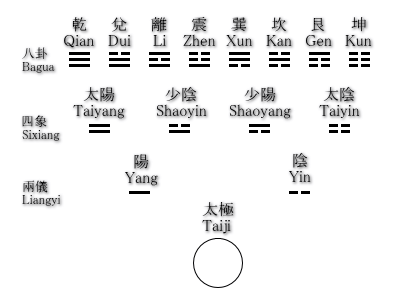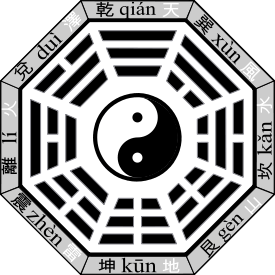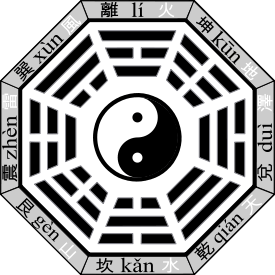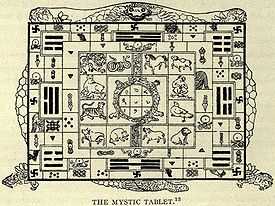Bagua
The bagua (Chinese: 八卦; literally "eight symbols") are eight trigrams used in Taoist cosmology to represent the fundamental principles of reality, seen as a range of eight interrelated concepts. Each consists of three lines, each line either "broken" or "unbroken," representing yin or yang, respectively. Due to their tripartite structure, they are often referred to as "trigrams" in English.
The trigrams are related to taiji philosophy, taijiquan and the wu xing, or "five elements".[1] The relationships between the trigrams are represented in two arrangements, the Primordial (先天八卦), "Earlier Heaven"[2] or "Fuxi" bagua (伏羲八卦), and the Manifested (後天八卦), "Later Heaven,"[2] or "King Wen" bagua. The trigrams have correspondences in astronomy, astrology, geography, geomancy, anatomy, the family, and elsewhere.[3][4]
The ancient Chinese classic I Ching consists of the 64 possible pairs of trigrams (called "hexagrams") and commentary on them.
| 乾 Qián ☰ |
兌 Duì ☱ |
離 Lí ☲ |
震 Zhèn ☳ |
巽 Xùn ☴ |
坎 Kǎn ☵ |
艮 Gèn ☶ |
坤 Kūn ☷ |
|---|---|---|---|---|---|---|---|
| Heaven/Sky | Lake/Marsh | Fire | Thunder | Wind | Water | Mountain | Earth |
| 天 Tiān | 澤(泽) Zé | 火 Huǒ | 雷 Léi | 風(风) Fēng | 水 Shuǐ | 山 Shān | 地 Dì |
Relation to other Principles

There are two possible sources of bagua: The first is from traditional Yin and Yang philosophy. The interrelationships of this philosophy has been attributed to Fuxi in the following way:
- 無極生有極、有極是太極、
太極生兩儀、即陰陽;
兩儀生四象: 即少陰、太陰、少陽、太陽、
四象演八卦、八八六十四卦
The Limitless (Wuji) produces the delimited, and this is the Absolute (Taiji)
The Taiji produces two forms, named yin and yang
The two forms produce four phenomena, named lesser yin, great yin (taiyin also means the Moon), lesser yang, great yang (taiyang also means the Sun).
The four phenomena act on the eight trigrams (bagua), eight eights are sixty-four hexagrams.
Another philosophical description of the source is the following, attributed to King Wen of Zhou Dynasty: "When the world began, there was heaven and earth. Heaven mated with the earth and gave birth to everything in the world. Heaven is Qian-gua, and the Earth is Kun-gua. The remaining six gua are their sons and daughters".
The trigrams are related to the five elements of wu xing, used by feng shui practitioners and in Traditional Chinese Medicine. Those five elements are wood, fire, earth, metal, and water. The Water (Kan) and Fire (Li) trigrams correspond directly with the Water and Fire elements. The element of Earth corresponds with both the trigrams of Earth (Kun) and Mountain (Gen). The element of Wood corresponds with the trigrams of Wind (Xun) (as a gentle but inexorable force that can erode and penetrate stone) and Thunder (Zhen). The element of Metal corresponds with the trigrams of Heaven (Qian) and Lake (Dui).
Fuxi "Earlier Heaven"

| 卦名 Name |
自然 Nature |
季节 Season |
性情 Personality |
家族 Family |
方位 Direction |
意義 Meaning |
|---|---|---|---|---|---|---|
| 乾 Qián | 天 Sky (Heaven) | Summer | Creative | 父 Father | 南 South | Expansive energy, the sky. For further information, see tiān. |
| 巽 Xùn | 風 Wind | Summer | Gentle | 長女 Eldest Daughter | 西南 Southwest | Gentle penetration, flexibility. |
| 坎 Kǎn | 水 Water | Autumn | Abysmal | 中男 Middle Son | 西 West | Danger, rapid rivers, the abyss, the moon. |
| 艮 Gèn | 山 Mountain | Autumn | Still | 少男 Youngest Son | 西北 Northwest | Stillness, immovability. |
| 坤 Kūn | 地 Earth | Winter | Receptive | 母 Mother | 北 North | Receptive energy, that which yields. For further information, see dì. |
| 震 Zhèn | 雷 Thunder | Winter | Arousing | 長男 Eldest Son | 東北 Northeast | Excitation, revolution, division. |
| 離 Lí | 火 Fire | Spring | Clinging | 中女 Middle Daughter | 東 East | Rapid movement, radiance, the sun. |
| 兌 Duì | 澤 Lake | Spring | Joyous | 少女 Youngest Daughter | 東南 Southeast | Joy, satisfaction, stagnation. |
King Wen "Later Heaven"

| 卦名 Name |
自然 Nature |
季节 Season |
性情 Personality |
家族 Family |
方位 Direction |
意義 Meaning |
|---|---|---|---|---|---|---|
| 離 Li | 火 Fire | Summer | Clinging | 中女 Middle Daughter | 南 South | Rapid movement, radiance, the sun. |
| 坤 Kun | 地 Earth | Summer | Receptive | 母 Mother | 西南 Southwest | Receptive energy, that which yields. |
| 兌 Dui | 澤 Lake | Autumn | Joyous | 少女 Youngest Daughter | 西 West | Joy, satisfaction, stagnation. |
| 乾 Qian | 天 Heaven | Autumn | Creative | 父 Father | 西北 Northwest | Expansive energy, the sky. |
| 坎 Kan | 水 Water | Winter | Abysmal | 中男 Middle Son | 北 North | Danger, rapid rivers, the abyss, the moon. |
| 艮 Gen | 山 Mountain | Winter | Still | 少男 Youngest Son | 東北 Northeast | Stillness, immovability. |
| 震 Zhen | 雷 Thunder | Spring | Arousing | 長男 Eldest Son | 東 East | Excitation, revolution, division. |
| 巽 Xun | 風 Wind | Spring | Gentle | 長女 Eldest Daughter | 東南 Southeast | Gentle penetration, flexibility. |
Bagua Used in Feng Shui
The Bagua is an essential tool in the majority of Feng Shui schools. The Bagua used in Feng shui can appear in two different versions: the Earlier Heaven Bagua, used for burial sites and the Later Heaven Bagua, used for the residences.
Xiantian Bagua
In Xiantian Bagua, also known as Fu Xi Bagua or Earlier Heaven Bagua, the Heaven is in the higher part and the Earth is in the lower part. The trigram Qian (Heaven) is at the top, in the South (in the past, the South was located at the top in Chinese maps), and Kun (Earth) at the bottom, in the North. Li (Fire) and Kan (Water) on the left and on the right-hand side form a pair. Zhen (Thunder) and Xun (Wind) form another pair, while being one opposite the other. Gen (Mountain) and Dui (Lake) form another pair, while being one opposite the other, in balance and harmony. The adjustment of the trigrams is symmetrical by forming exact contrary pairs. They symbolize the opposite forces of Yin and Yang and represent an ideal state, when everything is in balance.
Houtian Bagua
The sequence of the trigrams in Houtian Bagua, also known as the Bagua of King Wen or Later Heaven Bagua, describes the patterns of the environmental changes. Kan is placed downwards and Li at the top, Zhen in the East and Dui in the West. Contrary to the Earlier Heaven Bagua, this one is a dynamic Bagua where energies and the aspects of each trigram flow towards the following. It is the sequence used by the Luo Pan compass which is used in Feng Shui to analyze the movement of the Qi that affects us.
Bagua of the eight aspirations
Feng shui was made very popular in the Occident thanks to the Bagua of the eight aspirations. Each trigram corresponds to an aspect of life which, in its turn, corresponds to one of the cardinal directions. Applying feng shui using the Bagua of the eight aspirations made it possible to simplify feng shui and to bring it within the reach of everyone. The Masters of traditional feng shui call it Neo Feng Shui, for its simplicity, because it does not take into account the forms of the landscape or the temporal influence or the annual cycles. The Bagua of the eight aspirations is divided into two branches: the first, which uses the compass and cardinal directions, and the second, which uses the Bagua by using the main door. It is clear that, not taking into account the cardinal directions, the second is even more simplified.
Bagua map
A bagua map is a tool used in modern forms of feng shui to map a room or location and see how the different sections correspond to different aspects in one's life. These sections are believed to relate to every area or aspect of life and are divided into such categories as: fame, relationships/marriage, children/creativity, helpful people/travel, career, inner knowledge, family/ancestors/health, and wealth/blessings.
In this system, the map is intended to be used over the land, one's home, office or desk to find areas lacking good chi, and to show where there are negative or missing spaces that may need rectifying or enhancing in life or the environment.
For example, if the bagua grid is placed over the entire house plan and it shows the toilet, bathroom, laundry, or kitchen in the wealth/blessings area it would be considered that the money coming into that particular environment would disappear very fast, as if to be 'going down the drain.'
In popular culture

- Film
- The Filipino horror film Feng Shui is about a cursed Bagua mirror that involves a person getting killed in a way that relates to their Chinese zodiac if they stare at the Bagua mirror.
- In the film G.I. Joe: The Rise of Cobra, Snake-Eyes has the Bagua symbols for water and fire printed on the arm of his uniform, since the original comics had the same symbols as the arm tattoo used by members of the Arashikage clan (Snake-Eyes and Storm Shadow's clan).
- In the 2010 remake of The Karate Kid, the matches in the final contest sequence take place on large circular Bagua arrangements that delimit the combat area.
- Television
- In Jackie Chan Adventures, the trigrams are each written on a face of the Pan'ku Box and each of the trigrams represent their own demon sorcerer with corresponding nature.
- The television series Lost incorporated the Bagua into the logos for the DHARMA Initiative.
- Cartoons, manga and anime
- In the cartoon series Avatar: The Last Airbender, Airbending is based on Bagua. The Bagua appears again on Air Temple Island in Avatar's sequel series The Legend of Korra.
- In the manga and anime Naruto, the Hyuga clan's main attack is the Eight Trigrams Sixty-Four Palms.
- In the anime Cowboy Bebop episode "Boogie Woogie Feng Shui", the device that Maefa uses with the sunstone contains trigrams from the Bagua.
- Games
- In Indiana Jones and the Emperor's Tomb, there is a level where the player is tasked with solving a puzzle based on the Earlier Heaven Bagua.
- Ling Xiaoyu, a character from the Tekken series, uses various forms of Chinese martial arts, Bagua being one of those styles.
- In Touhou Project, a bullet hell series, the character Marisa Kirisame uses a "mini-Hakkero" with one of the Bagua diagrams on it.
- Music
- The 8 Diagrams, an album released by The Wu-Tang Clan in 2007, features an adaptation of the Bagua map on its cover.
- Marilyn Manson's 8th studio album, "Born Villain", makes extensive visual use of the trigrams.
- Other
- The Unicode character set has characters for each of the eight trigrams at codepoints U+2630 to U+2637:[5] (☰ ☱ ☲ ☳ ☴ ☵ ☶ ☷).
See also
- Flag of South Korea: the Taeguk Flag.
- Singapore dollar: the one dollar coin is shaped like a bagua.
- Flag of South Vietnam: a trigram representing "south".
- Baguazhang: a martial art based on principles derived from bagua.
- Taijiquan: the Taoist martial art that uses bagua principles.
- Tian gan and Di zhi: the archaic calendar system of East Asia.
- Tekes County, a planned community with a shape of a bagua.
References
- ↑ CHEN, Xin (tr. Alex Golstein). The Illustrated Canon of Chen Family Taijiquan, INBI Matrix Pty Ltd, 2007. page 11. (accessed on Scribd.com, December 14, 2009.)
- ↑ 2.0 2.1 Wilhelm, Richard; trans. by Cary F. Baynes, forward by C. G. Jung, preface to 3rd ed. by Hellmut Wilhelm (1967) (1950). The I Ching or Book of Changes. Princeton, NJ: Princeton University Press. pp. 266, 269. ISBN 069109750X.
- ↑ TSUEI, Wei. Roots of Chinese culture and medicine Chinese Culture Books Co., 1989.
- ↑ ZONG, Xiao-Fan and Liscum, Gary. Chinese Medical Palmistry: Your Health in Your Hand, Blue Poppy Press, 1999.
- ↑ http://unicode.org/charts/PDF/U2600.pdf
External links
| Wikimedia Commons has media related to Ba Gua. |
- Malaysia Iching Net
- The Spiritual Feng Shui
- Kheper.net on the trigrams
- Bagua
- The oirigin of Bazhai Feng Shui based on the Bagua